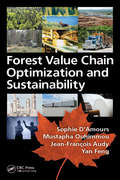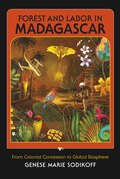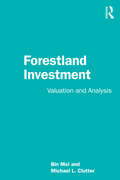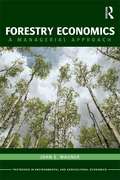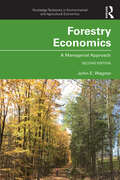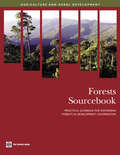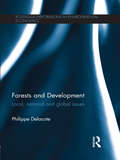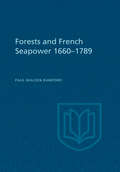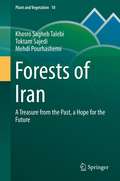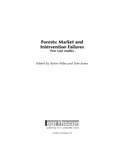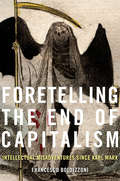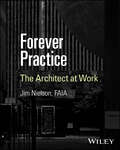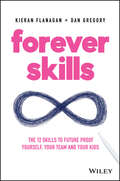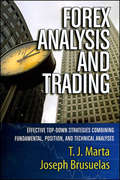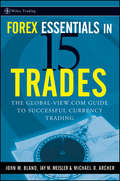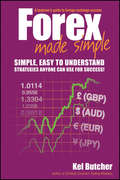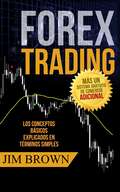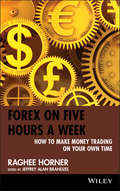- Table View
- List View
Forest Value Chain Optimization and Sustainability
by Sophie D’Amours, Mustapha Ouhimmou, Jean-François Audy and Yan FengThis book provides a global perspective on the various issues that the industry has to face as well as to provide some key global strategies that can help coping with those global challenges, such as collaboration, strategic value chain planning, and interdependency analyses. It presents literature reviews, strategic research orientations, assessment of some current key issues, and state-of-the-art methodologies.
Forest and Biomass Harvest and Logistics
by Jingxin WangThis book explains forest and woody biomass harvest, harvesting machines, systems, logistics, supply chain management, best management practices, harvest scheduling and carbon sequestration. It also covers applications of harvesting principles in forest and biomass management practices. The book provides an in-depth understanding of functions and applications of current and future harvesting technologies, the unique characteristics of harvesting machine with respect to cost, productivity, and environmental impacts. Special features include harvest machine illustrations and images of field operations, tabular presentations of filed studies of forest operations and detailed modelling processes for forest and biomass harvest logistics and supply chain management. Specifically, the book is designed for students, researchers, educators, and practitioners in the field of forest and biomass harvest and logistics. The book’s contents have been tested in teaching as the Harvesting Forest Product class for undergraduates and graduates in the Division of Forestry and Natural Resources at West Virginia University since 2000. The information contained in this book is a robust reference resource for students who would be future forest and biomass managers, timber contractors, entrepreneurs, researchers, and educators in the fields of forest and biomass operations, engineering, and resource management.
Forest and Labor in Madagascar: From Colonial Concession to Global Biosphere
by Genese Marie SodikoffA study of the demands of economic development and ecological conservation on the African island country.Protecting the unique plants and animals that live on Madagascar while fueling economic growth has been a priority for the Malagasy state, international donors, and conservation NGOs since the late 1980s. Forest and Labor in Madagascar shows how poor rural workers who must make a living from the forest balance their needs with the desire of the state to earn foreign revenue from ecotourism and forest-based enterprises. Genese Marie Sodikoff examines how the appreciation and protection of Madagascar’s biodiversity depend on manual labor. She exposes the moral dilemmas workers face as both conservation representatives and peasant farmers by pointing to the hidden costs of ecological conservation.“Sodikoff takes us deep into the underbelly of conservation in one of the world’s biodiversity “hot-spots.” It is a world of timber barons, logging gangs, corrupt state functionaries, international conservation experts, worker-peasants, and poachers. She paints eastern Madagascar as a frontier of dispossession, exploitation, and violence. The plundering of the Mananara protected area is seen, in a brilliantly original way, from the subaltern vantage point of forest workers and conservation labor. Forest and Labor places present day conservation on the larger canvas of a century of forest-based social relations of labor that have entered into the making of what Sodikoff calls neoliberal conservation. It is a magnificently rich historical and ethnographic accounting of what passes as the making of global biosphere reserves. A tour de force.” —Michael Watts, UC Berkeley“An important and lively contribution to the study of “green neoliberalism.” An obvious choice for undergraduate teaching on ecology, rights, international political economy, development, and a host of other topics.” —David Graeber, University of London“Brings a whole new angle and nuance to the crucial debates over conservation and development. Applicable not just to lush, humid eastern Madagascar, but all around the globe.” —Christian Kull, Monash University“Those interested in conservation, tropical rainforest ecology, international political economy, and sustainable development will find Forest and Labor in Madagascar an insightful case study.” —Choice
Forestland Investment: Valuation and Analysis
by Bin Mei Michael L. ClutterForestland investment has surged in the past few decades as a result of land ownership change in the forestry industry. Timberland investment and management organizations and real estate investment trusts have bought up land and resources that were divested by vertically integrated forest products companies. This book provides a seminal coverage of this seismic shift in the industry, exploring the philosophy, driving factors, valuation, theory, research, implementation, practice, and effects of forestland investment. Across 15 chapters the book reviews the history of forestland investment; discusses the optimal forest rotation; explains timberland appraisal; examines the return drivers of forestland; analyzes timberland index construction methods and results; prices timberland assets; reviews financial and real options; investigates real option values in forestland management; evaluates timber harvest contracts; examines new opportunities in the emerging woody bioenergy market; and eventually offers prospects on forestland investment in the future. It also discusses how forest carbon can be used as a nature-based climate solution. This book is essential reading for forestry business students and scholars, as well as practitioners and policymakers in the industry.
Forestry Economics: A Managerial Approach (Routledge Textbooks In Environmental And Agricultural Economics Ser.)
by John E. WagnerForestry Economics introduces students and practitioners to all aspects of the management and economics of forestry. The book adopts the approach of managerial economics textbooks and applies this to the unique processes and problems faced by managers of forests. While most forestry economics books are written by economists for future economists, what many future forest and natural resource managers need is to understand what economic information is and how to use it to make better business and management decisions. John E. Wagner draws on his twenty years of experience teaching and working in the field of forest resource economics to present students with an accessible understanding of the unique production processes and problems faced by forest and other natural resource managers. There are three unique features of this book: The first is its organization. The material is organized around two common economic models used in forest and natural resources management decision making. The second is the use of case studies from various disciplines: Outdoor and Commercial Recreation, Wood Products Engineering, Forest Products, and Forestry. The purpose of these case studies is to provide students with applications of the concepts being discussed within the text. The third is revisiting the question of how to use economic information to make better business decisions at the end of each chapter. This ties each chapter to the preceding ones and reinforces the hypothesis that a solid working knowledge of these economic models and the information they contain are necessary for making better business decisions. This textbook is an invaluable source of clear and accessible information on forestry economics and management for not only economics students, but for students of other disciplines and those already working in forestry and natural resources.
Forestry Economics: A Managerial Approach (Routledge Textbooks in Environmental and Agricultural Economics)
by John E. WagnerForestry Economics introduces students and practitioners to the economics of managing forests and forest enterprises. The book adopts the approach of managerial economics textbooks and applies this to the unique problems and production processes faced by managers of forests and forest enterprises. What many future forest and natural resource managers need is to understand what economic information is and how to use it to make better business and management decisions. John E. Wagner draws on his 30 years of experience teaching and working in the field of forest resource economics to present students with an accessible understanding of the unique production processes and problems faced by forest and other natural resource managers. The second edition has been updated to include: Expanded discussion of compounding, discounting, and capital budgeting, as well as an expanded discussion of when to replace a capital asset that has (i) costs but no direct revenue stream such as a machine; (ii) costs and a direct annual revenue stream such as a solar array; or (iii) costs and a periodic revenue stream illustrated by the forest rotation problem. New practical examples to provide students with applications of the concepts being discussed in the text, most notably on New Zealand and a Radiata Pine (Pinus radiata) Plantation. A brand-new chapter that develops business plans for for-profit businesses to illustrate how a business plan is derived from the economic information contained within the Architectural Plan for Profit and how it can be used to make business decisions about continuing to operate a business or to start a new business. This textbook is an invaluable source of clear and accessible information on forestry economics and management not only for economics students, but also for students of other disciplines and those already working in forestry and natural resources.
Forestry Economics: A Managerial Approach (Routledge Textbooks in Environmental and Agricultural Economics)
by John E. Wagner- Each chapter introduces one or more key concepts in managerial economics and then illustrates the importance of those ideas by showing how they can be applied when making business decisions.- The inclusion of numerous case studies throughout the book enables students to see how forestry and natural resource management works in practice.- A new chapter on developing and writing business plans highlights a managerial tool and allows students to put the ideas developed throughout the book into practice.
Forestry and the New Institutional Economics: An Application of Contract Theory to Forest Silvicultural Investment (Routledge Revivals)
by Sen Wang G. Cornelis KootenThis title was first published in 2001. Using a case study from British Columbia, this book addresses the economies of institutions, institutional change and transactions costs and develops the theory of the New Institutional Economics in the context of forestry institutions. This approach to economic analysis of forestry investment problems will emphasize the understanding of the linkages between the biological as well as institutional attributes of forestry activities.
Forests Sourcebook
by World BankThe 'Forests Sourcebook' provides practical operations-oriented guidance for forest sector engagement toward the goals of poverty reduction, conservation and economic development. Intended to guide World Bank lending activities and projects, the 'Forests Sourcebook' offers information useful to a broad audience of practitioners, government agencies, and non-governmental organizations. The 'Sourcebook was developed in partnership with members of the Collaborative Partnership on Forests, including the Food and Agriculture Organization. The 'Sourcebook' provides background on key issues, lessons learned, and recommendations for practitioners on a number of topics including private sector engagement, forest governance, sustainable plantation and commercial harvesting, and forest information management systems. Giving insight into the complex interplay between different realms of development work that effect or are affected by forests, the 'Forests Sourcebook' is a valuable tool for any stakeholder involved in development or business projects that could have impact on forests.
Forests and Development: Local, National and Global Issues (Routledge Explorations in Environmental Economics #37)
by Philippe DelacoteThis book is a fully up to date study of the major issues facing forest conservation and the forestry industry, which considers developments at local, national and global levels. Environmental and development topics relating to each level are discussed – for instance, the use of forest products in a rural poverty context, corruption and forest harvesting and consumption as a political device. Delacote employs a quantitative approach in order to analyse the plight of tropical forests in the developing world, and in doing so produces a range of interesting conclusions. This methodology fills a crucial research gap in existing studies of forests in a development context – increased use of theoretical tools to interpret real life situations might be beneficial to the field. Therefore, the first objective of this book is to provide a sample of theoretical analysis concerning the forests and development nexus. The second objective is to supply empirical economists with new theoretical insights, with the hope that those results can emerge with conclusive field testing and relevant policy recommendations.
Forests and French Sea Power, 1660-1789
by Paul Walden BamfordBy choosing to concentrate upon discovering what forest resources were available to the French navy during the ancien régime and what use it was able to make of them, Mr. Bamford has not only provided the first monograph on that subject in the English language, but has gone far toward explaining why France was the loser in the long duel with England for the control of commerce and the extension of empire. <P><P> Two years of research in the Archives Nationales and in the Archives de la Marine in Paris, Toulon, and Rochefort enabled him to draw on contemporary sources of information of which little, if any, use has been made before, and a further year of research in the libraries of New York City, particularly in the rich Proudfit Naval Collection, also yielded new material. It is Mr. Bamford's achievement to have handled this vast store of primary sources with such skill and judgement that the reader, by turning over letters from disgruntled forest proprietors, reports from harassed maîtres on the trickery and recalcitrance of the peasants, instructions from the top echelon of the navy to inspectors in the forests, and a variety bills, receipts, and memoranda, is given at first hand an appreciation of the difficulties faced by the navy in trying to obtain timber and masts of the choice quality required for building ships-of-the-line. The navy had to compete with the merchant marine and with industrial and private users of fuel for supplies that were continually being depleted by mismanagement and by the conversion of forests to arable land. Measures, superficially admirable, for conserving the forests are found on closer examination to be at once over-precise and not properly enforced. Transport, even in a country so abundantly supplied with navigable rivers as France, was expensive and difficult.<P>Not only historians, but scholars in the field of forestry, economics, geography, agriculture, and transport will find this book illuminating.
Forests of Iran
by Khosro Sagheb Talebi Toktam Sajedi Mehdi PourhashemiThe work describes the general ecological aspects of Iran as well as West and Central Asia in the introduction. The book includes three chapters, each describing the climate, geology and soil characteristics, vegetation and forest types, site demands of the main tree species and the ecogram of them, management and socio-economic issues of three different phytogeographical regions, mainly the Hyrcanian, Irano-Turanian, and Saharo-Sindian. Each chapter contains a table for introducing the English and Botanical names of the plant species mentioned in the chapter. The information presented in this book is based on personal experiences and results of research projects of the authors, as well as experiences of other forest scientists in Iran. The references are given at the end of each chapter separately. The book contains 10 tables, 37 black and white and 55 color pictures.
Forests: Five case studies (Environmental and Resource Economics Set)
by Tom Jones Soren WibeThe economic value of forest. has long been recognized, but the ways in which that value is calculated and the management policies adopted in consequence have all too often resulted in overuse and irreversible destruction. This is spectacularly obvious around the Mediterranean basin, but it is also true in northern Europe. These five case studies, commissioned by the OECD, examine failures of forest management in Britain, Spain, Italy, Germany and Sweden. They look at both market and intervention policies and show how each can further the destruction of the forests, and they set out ways in which future policies can evade the mistakes of the past. Originally published in 1992
Foretelling the End of Capitalism: Intellectual Misadventures since Karl Marx
by Francesco BoldizzoniIntellectuals since the Industrial Revolution have been obsessed with whether, when, and why capitalism will collapse. This riveting account of two centuries of failed forecasts of doom reveals the key to capitalism’s durability. Prophecies about the end of capitalism are as old as capitalism itself. None have come true. Yet, whether out of hope or fear, we keep looking for harbingers of doom. In Foretelling the End of Capitalism, Francesco Boldizzoni gets to the root of the human need to imagine a different and better world and offers a compelling solution to the puzzle of why capitalism has been able to survive so many shocks and setbacks. Capitalism entered the twenty-first century triumphant, its communist rival consigned to the past. But the Great Recession and worsening inequality have undermined faith in its stability and revived questions about its long-term prospects. Is capitalism on its way out? If so, what might replace it? And if it does endure, how will it cope with future social and environmental crises and the inevitable costs of creative destruction? Boldizzoni shows that these and other questions have stood at the heart of much analysis and speculation from the early socialists and Karl Marx to the Occupy Movement. Capitalism has survived predictions of its demise not, as many think, because of its economic efficiency or any intrinsic virtues of markets but because it is ingrained in the hierarchical and individualistic structure of modern Western societies. Foretelling the End of Capitalism takes us on a fascinating journey through two centuries of unfulfilled prophecies. An intellectual tour de force and a plea for political action, it will change our understanding of the economic system that determines the fabric of our lives.
Forever Barbie: The Unauthorized Biography Of A Real Doll
by M.G. LordBarbie is a strong, independent doll. But is she a feminist icon? It’s complicated. Since her introduction in 1959, Barbie’s impact has been revolutionary. Far from being a toy designed by men to oppress women, she was a toy invented by women to teach women what was expected of them, for better or for worse. Whether tarred-and-glittered as antifeminist puffery or celebrated as a feminist icon (or, at any rate, an important cultural touchstone in understanding feminism) Barbie has undeniably influenced generations of girls. In Forever Barbie, cultural critic, investigative journalist, and first-generation Barbie owner M. G. Lord uncovers the surprising story behind Barbie’s smash success. Revealing her low origins as “Bild Lilli,” a risqué doll for adults sold as a gag gift in postwar Germany, Forever Barbie traces Barbie’s development and transformation, through countless makeovers and career changes, into an international pop culture icon and now “traditional toy.” Though not every doll in the line has been a hit—with pregnant Midge and Growing up Skipper among the more intriguing disasters—Barbie’s endurance, Lord writes, speaks as much to Mattel’s successful marketing as it does to our society’s overall ambivalence toward femininity. With new accessories, including a preface on the latest developments in the Barbieverse, Forever Barbie “will make you think of America’s most celebrated plastic doll in ways you never have before” (Susan Faludi).
Forever Practice: The Architect at Work
by Jim NielsonA Practical Guide to the Career and Practice of Architecture Where will architecture take you? Find answers in Forever Practice: The Architect at Work, a thoughtful and accessible book by author Jim Nielson, FAIA. Drawn from decades of experience and study, this engaging new book immerses the reader in best practices and proven tools for success. In 28 brisk chapters, this book lends readers a glimpse of the architect in practice. It instills confidence and purpose. The author demystifies the profession, crafting his narrative—about licensure, project management, sustainability, and so much more—from the fodder of experience, case studies, and savvy. Empowering readers to embrace their role (or their future) as a practitioner, Forever Practice: The Architect at Work: Offers concrete steps for leading a collaborative team from project conception through completionIncludes a wealth of insights and lessons learned to prepare readers for challenges in the fieldFeatures practice management tools and discussion topics for classroom and independent learningAddresses key professional standards, including codes of conduct, ethics, and the standard of care Forever Practice: The Architect at Work is perfect for architecture students enrolled in professional practice courses. It is also ideal for early-career professionals and seasoned practitioners seeking to deepen their understanding of practice management and design team leadership. “In this book, Forever Practice: The Architect at Work, Jim Nielson, FAIA undertakes the task of introducing the reader to those business skills an emerging architectural professional, as well as a more seasoned professional, needs to succeed over a long career. It’s all there, plus additional resources to explore these topics more deeply. After reading this book, you’ll want to keep it near your computer as a valued reference.” —RK Stewart, FAIA, Hon FRAIC, Hon JIA, Hon AIA, 2007 AIA National President “I wish I had had Jim’s book when I was in practice.” — John S. Reynolds, FAIA, Emeritus, Professor Emeritus, University of Oregon, Co-author, Mechanical and Electrical Equipment for Buildings “For years Jim has played an active role in the regulatory process governing the profession of architecture at the local and national level. This book helps readers — from aspiring architects to seasoned practitioners — come to understand the general requirements of licensure and professional practice.” — Harry M. Falconer, Jr., FAIA, NCARB, HonD BAC, Hon FCARM, Former Senior Architect | Vice President, Policy + International Relations, NCARB
Forever Skills: The 12 Skills to Futureproof Yourself, Your Team and Your Kids
by Kieran Flanagan Dan GregoryWhat skills will matter most for work, business and life in the future? Where should you focus your energy and effort when the world is changing at an extraordinary rate? How can you future proof yourself, your organisation and your kids? In this ground-breaking book Kieran Flanagan and Dan Gregory have interviewed hundreds of successful business people, educators, futurists, economists and historians to uncover the key skills that will always be critical to success in business and in life. Where most futurists increase your sense of panic and anxiety with dystopian images of the not-too-distant future characterised by Artificial Intelligence (AI) taking our jobs, algorithms hacking our most private moments and Austrian-accented cyborgs raising our children, Kieran and Dan remind us that we need to look beyond the things changing around us and focus on the things that won’t change within us. Identify the skills you have that will always be relevant Gain insight from business leaders, entrepreneurs, educators, sport leaders and more Learn why each skill matters, and how to make it stronger Discover the things that won’t change as we inch toward the future These 12 FOREVER SKILLS are designed to set you up for whatever the future may throw at you plus help you get more success in your work and life, today.
Forever: De Beers and U.S. Antitrust Law
by Jennifer Burns Debora L. SparFor over a century, the international diamond market has been dominated by one of the most successful cartels on earth. Run by the legendary De Beers Corp., the cartel has managed to keep diamond prices increasing and to prevent the defection that dooms most other "orderly marketing arrangements." It has also managed to uphold one of the greatest marketing coups of history: convincing millions of customers that diamonds are actually rare and therefore highly prized. There is only one problem for the cartel. It is illegal in the United States (the world's largest market for gem diamonds) and has been under constant attack by the U.S. Justice Department. The case describes how De Beers has dealt with this problem in the past and how, in the late 1990s, changes in the African political situation and the world diamond market may suggest a new relationship with the U.S. government.
Forex Analysis and Trading: Effective Top-Down Strategies Combining Fundamental, Position, and Technical Analyses (Bloomberg Financial #43)
by Joseph Brusuelas T. J. MartaThe forex market is huge and offers tremendous trading opportunities. There are many different tools for analyzing the forex market. But what are the best tools and the best ways to use them to trade most effectively? Forex Analysis and Trading organizes the most widely used—although disparate—approaches to forex analysis into one synergistic, robust, and powerful framework. This system draws on fundamental, position, and technical analyses to identify profitable currency positions, enabling traders to make the best decisions regarding major currencies. Marta and Brusuelas are forex trading professionals with years of experience analyzing and trading every major currency.
Forex Essentials in 15 Trades
by Archer Michael Duane Bland John Meisler JayTraders are constantly learning their craft. Those who do not share information, discuss tactics and review prior trades are doomed for failure. Global-View. com knows this. It is the leading destination for Forex traders looking to learn and discuss trading. With over 33,000 registered users from 125 countries, Global-View. com exposes its users to an incredible base of knowledge. In this book, the authors dissect each of 15 chosen trades, using the material to expose some of the best (and worst) practices of a Forex trader. The book weaves a plethora of Global-View. com information into the detailed dissection. Each description will include how the trade was selected and why it was made, as well as money management and psychological aspects of the trade. Entertaining anecdotal stories are interspersed throughout each trade story.
Forex Made Simple: A Beginner's Guide To Sharemarket Success
by ButcherForex Made Simple is the essential guide for anyone who wants to make money trading foreign exchange, without all the fuss You don't need to be a financial wizard or spend all day glued to a computer screen to trade forex profitably. Including the information you need to know (and nothing more), this book provides straightforward strategies anyone can use--no expensive broker required! Inside you'll find information on: currencies and economies types of forex markets retail forex dealers and market makers placing trades economic indicators and events that affect exchange rates money and risk management If you're ready to take the plunge into the forex market and maximize your success without all the stress, this is the book for you.
Forex Patterns and Probabilities
by Ed PonsiWhile most books on trading deal with general concepts and shy away from specifics, Forex Patterns and Probabilities provides you with real-world strategies and a rare sense of clarity about the specific mechanics of currency trading. Leading trading educator Ed Ponsi will explain the driving forces in the currency markets and will provide strategies to enter, exit, and manage successful trades. Dozens of chart examples and explanations will guide you each step of the way and allow the reader to "look over the shoulder" of a professional trader hard at work at his craft. This book provides traders with step-by-step methodologies that are based on real market tendencies. The strategies in this book are presented clearly and in detail, so that anyone who wishes to can learn how to trade like a professional. It is written in a style that is easy to understand, so that the reader can quickly learn and use the techniques provided.
Forex Trading: Los conceptos básicos explicados en términos simples
by Jim BrownEste libro es para aquellos de ustedes que están empezando a considerar operar en Forex pero no saben por dónde empezar, debido a la abundancia de información en Internet. Es un buen primer libro para leer, para obtener una comprensión de los fundamentos. Como bono adicional, Jim ofrece uno de sus sistemas de operaciones, así como los indicadores sin ningún otro costo adicional. A continuación se presenta un resumen de lo que se incluye en el libro: ¿Qué es el Forex? Ventajas de operar con Forex Cuando el mercado Forex se encuentra abierto Pares de divisas Dónde operamos Forex Elección de un corredor Información importante para los operadores con sede en los EE.UU. Tamaño de lote y valor pip equivalente Información sobre el riesgo Noticias y análisis fundamentales Análisis técnico Relación riesgo-recompensa Tipos de órdenes ¿Cuántos pips son suficientes? Psicología del comercio ¿Operaciones en el día o a largo plazo? Llevar un diario o agenda Sin ningún costo adicional (o en los costos) Jim comparte con sus lectores: Sus indicadores personalizados para la plataforma MT4 MetaTrader, como una descarga al final del libro. Y cualquiera que haya recibido estos indicadores también recibirá la versión MT5 de sus archivos cuando se hayan programado. Una invitación a unirse a su grupo en Facebook, en el que participan tanto operadores nuevos como experimentados de Forex. Interacción diaria en su grupo de Facebook Llama a sus operaciones en vivo, comparte sus resultados y graba un video semanal de análisis de operaciones. Sus datos de contacto si necesita más aclaraciones.
Forex Trading: para Iniciantes (Como... #17)
by Owen JonesForex Trading para Iniciantes Eu espero que você ache as informações aqui contidas instrutivas, úteis e proveitosas. As informações neste ebook sobre FOREX trading e artigos relacionados estão organizadas em 18 capítulos de aproximadamente 500-600 palavras cada. Elas o ajudarão a desenvolver estratégias de trading e até poderão ajudá-lo a aventurar-se em um novo, lucrativo passatempo. O mínimo que elas farão é poupá-lo de centenas de conselhos profissionais, mas com um bônus adicional: Eu estou lhe concedendo permissão para usar o conteúdo em seu próprio site ou seu próprio blog e informativo, embora seja melhor você reescrevê-los em suas próprias palavras primeiro. Você também pode dividir o livro e revender os artigos. Na verdade, o único direito que você não tem é revender ou distribuir o livro como ele foi entregue a você.
Forex on Five Hours a Week: How to Make Money Trading on Your Own Time
by Raghee Horner Jeffrey Alan BrandzelA top forex trader reveals how to ease into this market and excel Trading the forex market has become one of the most popular forms of trading, mainly because of its twenty-four-hour access and the fact that there is always a bull market available in this arena. But not everyone is interested in quitting their jobs and spending all day trying to make a living trading. That's where Forex in Five Hours a Week comes in. This book shows readers how they can master a few techniques, focus their efforts on their choice of time frame, and profit in the forex market. Readers with a day job and little time to dedicate to the market will learn all they need to know to capture consistent profits
